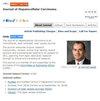Adjuvant Transarterial Chemoembolization Plus Immunotherapy for Huge Hepatocellular Carcinoma: A Propensity Score Matching Cohort Study
IF 4.2
3区 医学
Q2 ONCOLOGY
引用次数: 0
Abstract
Purpose: The prognosis of patients with huge hepatocellular carcinoma (huge HCC, diameter ≥ 10 cm) is poor owing to the high early recurrence rate. This study aimed to explore the clinical value of postoperative adjuvant transarterial chemoembolization (PA-TACE) plus programmed cell death-1 (PD-1) inhibitors for huge HCC.Patients and Methods: Data from consecutive huge HCC patients treated with hepatectomy during June 2017 and July 2022 were retrospectively collected. Baseline differences were balanced between huge HCC patients who underwent PA-TACE with (AIT group) or without PD-1 inhibitors (AT group) by propensity-score matching (PSM). We compared recurrence-free survival (RFS), overall survival (OS) and recurrence patterns between the two groups. Independent risk factors for RFS and OS were confirmed by Cox regression analysis, and subgroup analysis was also conducted.
Results: A total of 294 patients were enrolled, and 77 pairs of patients in the AIT and AT groups were matched by PSM. The 1-year and 2-year RFS were 49.9% and 35.7% in the AIT group compared to 24.7% and 15.5% in the AT group respectively (p< 0.001). The 1-year and 2-year OS were 83.6% and 66.9% in the AIT group compared to 50.6% and 36.8% in the AT group respectively (p< 0.001). There were no significant differences in recurrence patterns between the two groups. Multivariable analysis demonstrated that combined therapy of PA-TACE plus PD-1 inhibitors was a protective factor related to both RFS and OS.
Conclusion: PA-TACE plus PD-1 inhibitors could improve survival outcomes for huge HCC patients.
Keywords: hepatocellular carcinoma, postoperative adjuvant therapy, programmed cell death-1 inhibitors, transarterial chemoembolization, early recurrence
巨大肝细胞癌辅助经动脉化疗栓塞加免疫疗法:倾向得分匹配队列研究
目的:巨大肝细胞癌(巨大HCC,直径≥10厘米)患者由于早期复发率高而预后较差。本研究旨在探讨巨大肝细胞癌术后辅助经动脉化疗栓塞(PA-TACE)加程序性细胞死亡-1(PD-1)抑制剂的临床价值:回顾性收集2017年6月至2022年7月期间接受肝切除术治疗的连续巨大HCC患者的数据。通过倾向分数匹配(PSM)平衡了接受PA-TACE治疗并使用(AIT组)或不使用PD-1抑制剂(AT组)的巨大HCC患者之间的基线差异。我们比较了两组患者的无复发生存期(RFS)、总生存期(OS)和复发模式。通过Cox回归分析确认了RFS和OS的独立风险因素,并进行了亚组分析:共有294名患者入组,77对AIT组和AT组患者进行了PSM配对。AIT组的1年和2年RFS分别为49.9%和35.7%,而AT组分别为24.7%和15.5%(p< 0.001)。AIT组的1年和2年OS分别为83.6%和66.9%,而AT组分别为50.6%和36.8%(p< 0.001)。两组的复发模式无明显差异。多变量分析表明,PA-TACE加PD-1抑制剂的联合治疗是RFS和OS的保护因素:PA-TACE加PD-1抑制剂可改善巨大HCC患者的生存预后。 关键词:肝细胞癌;术后辅助治疗;程序性细胞死亡-1抑制剂;经动脉化疗栓塞;早期复发
本文章由计算机程序翻译,如有差异,请以英文原文为准。
求助全文
约1分钟内获得全文
求助全文

 求助内容:
求助内容: 应助结果提醒方式:
应助结果提醒方式:


